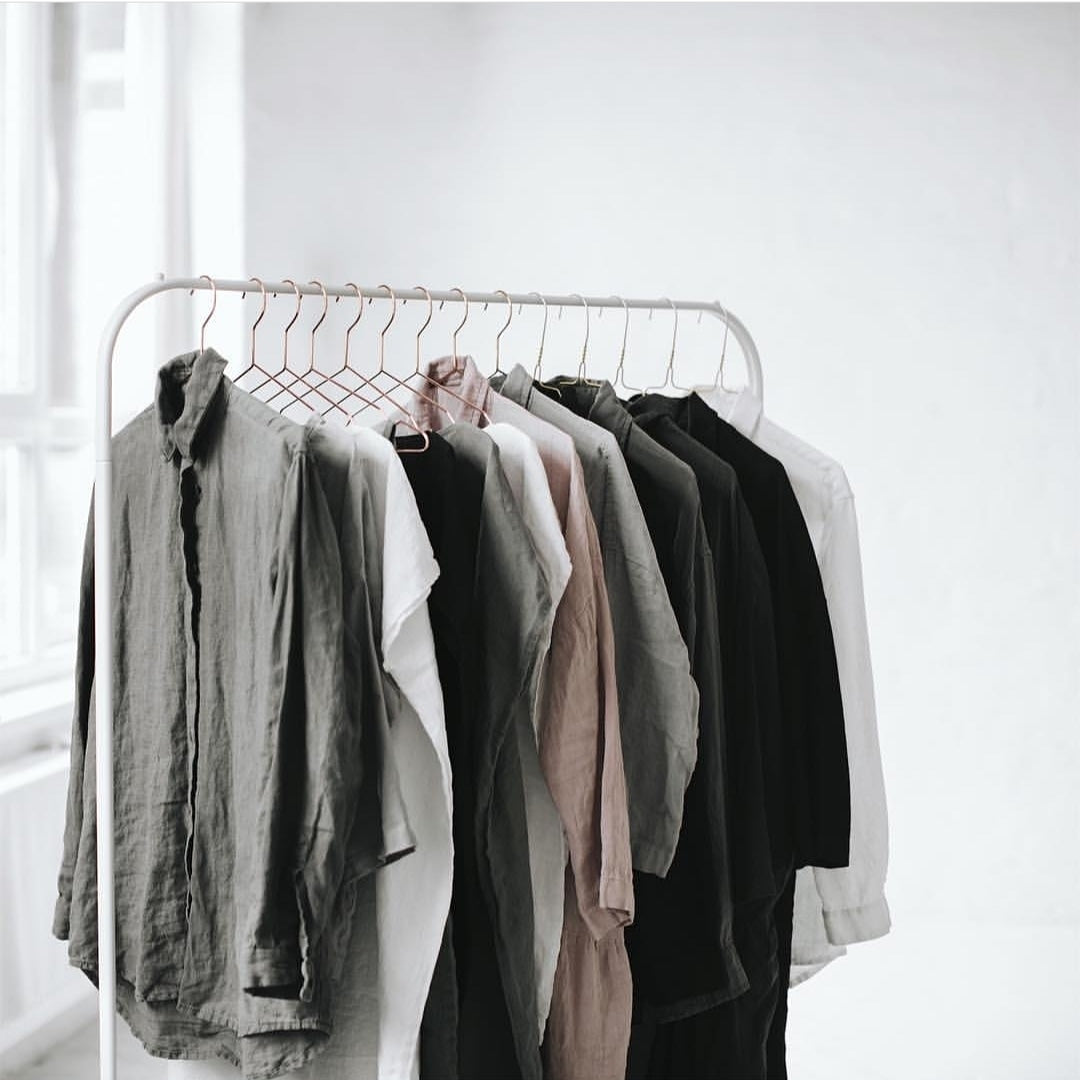For Kiwis after a bit of everyday luxury in their bedding, bamboo sheets are a brilliant choice. They offer an incredible softness and are fantastic at regulating temperature, which is perfect for New Zealand's famously changeable climate. Add in their eco-friendly reputation and hypoallergenic qualities, and you've got a practical, popular upgrade for any modern bedroom.
Why Kiwis Are Choosing Bamboo Sheets
If you take a peek into modern New Zealand bedrooms, you’ll likely spot a quiet revolution underway. Bamboo sheets have gone from being a niche eco-product to a firm favourite for Kiwis who value real comfort. And it's not hard to see why. The appeal isn't just about how soft they feel; it's about a lifestyle that prizes quality, sustainability, and a touch of everyday indulgence.
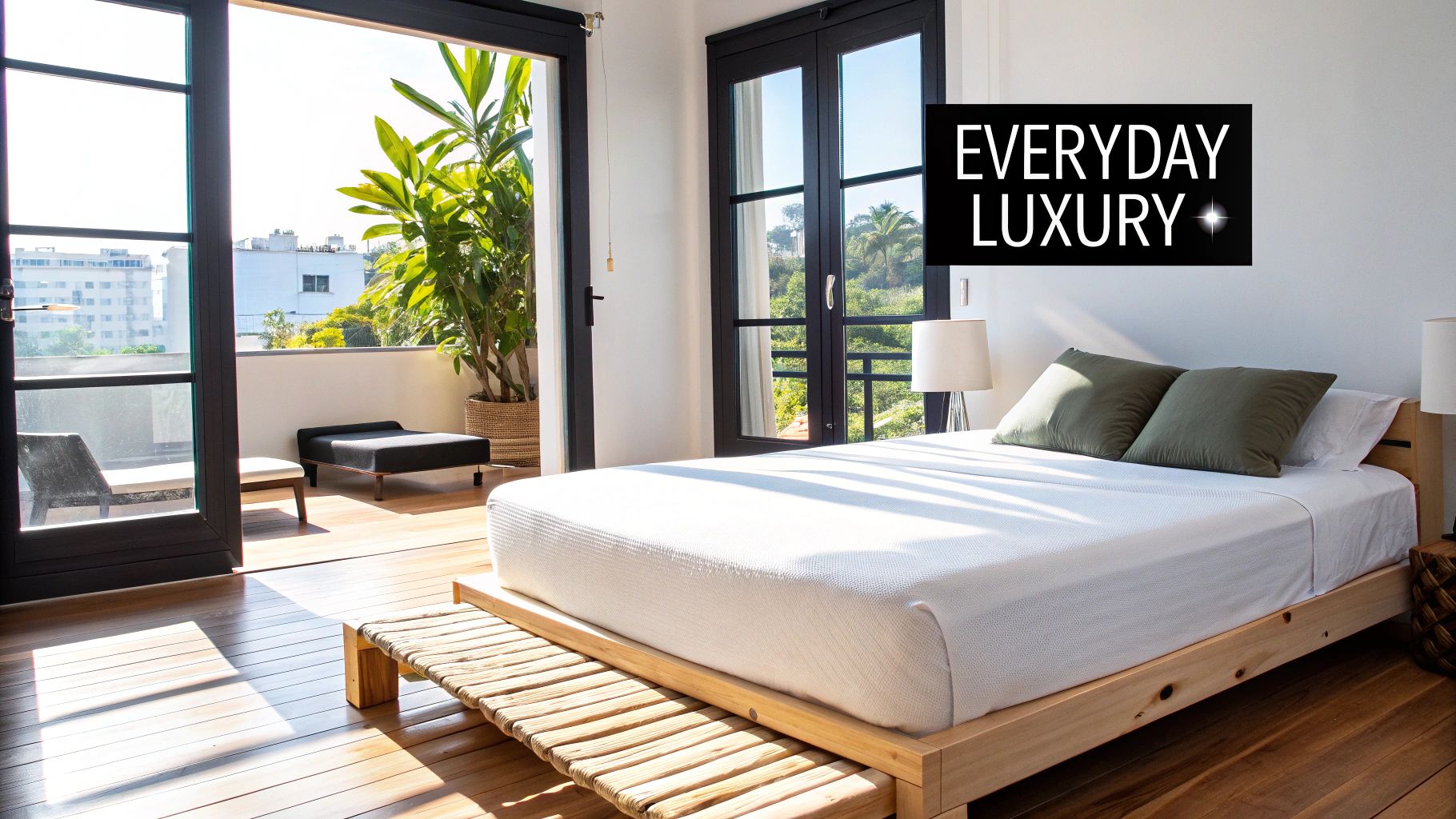
This isn't just a passing fad. The bedding market here in New Zealand is growing steadily, with experts predicting a compound annual growth rate (CAGR) of 6.4% from 2025 to 2035. A big part of that boom is our love for high-quality, sustainable homewares, and bamboo is perfectly positioned as a leading alternative to old-school materials.
The Immediate Appeal
So, what convinces someone to try bamboo sheets for the first time? It usually boils down to two game-changing experiences:
- Unmatched Softness: People often compare it to silk or top-tier Egyptian cotton. Bamboo fabric has this unique, smooth drape that just feels incredible against your skin. It’s a completely different level of softness.
- Superior Breathability: The natural structure of bamboo fibres allows air to move freely. This is a huge win for temperature regulation, keeping you cool on those humid Auckland nights but also cosy and warm when a Canterbury frost hits.
This blend of pure comfort and smart performance really hits the mark in a country where we appreciate things that are both beautiful and genuinely useful. If you're curious about the specifics, you can learn more about bamboo bed sheets and what makes them tick.
A Perfect Match for the Kiwi Lifestyle
Beyond the feel-good factor, bamboo sheets just seem to fit with our values. There's a real and growing desire for products that are not only a pleasure to use but are also made with the planet in mind. While the full eco-story has its nuances, the bamboo plant itself is a champion of renewability, and that resonates with a nation that's rightly proud of its natural beauty.
Choosing bamboo is often a conscious move towards investing in better sleep and a more sustainable home. It’s a simple upgrade that makes a real difference to your daily life, mixing comfort with conscious consumerism.
At the end of the day, the rise of bamboo sheets in New Zealand is all about wanting something better. Better sleep, better quality, and a better fit with what matters to us. They’re a simple but significant way to make your home a more comfortable, thoughtful sanctuary.
Decoding Different Types of Bamboo Fabric
When you start shopping for bamboo sheets in New Zealand, you’ll quickly realise that not all "bamboo" is created equal. The raw material might be the same incredible plant, but how it's transformed into bedding dramatically changes its feel, durability, and eco-credentials.
Think of it like grapes and wine. The grape variety is the starting point, but the winemaking process determines whether you end up with a crisp Sauvignon Blanc or a rich Merlot. It’s the same with bamboo.
To make a smart purchase, you need to know the main players. Here in New Zealand, you'll generally find three types of bamboo fabric, each with a unique backstory.
This infographic breaks down the core differences in how each type of bamboo fabric is made.
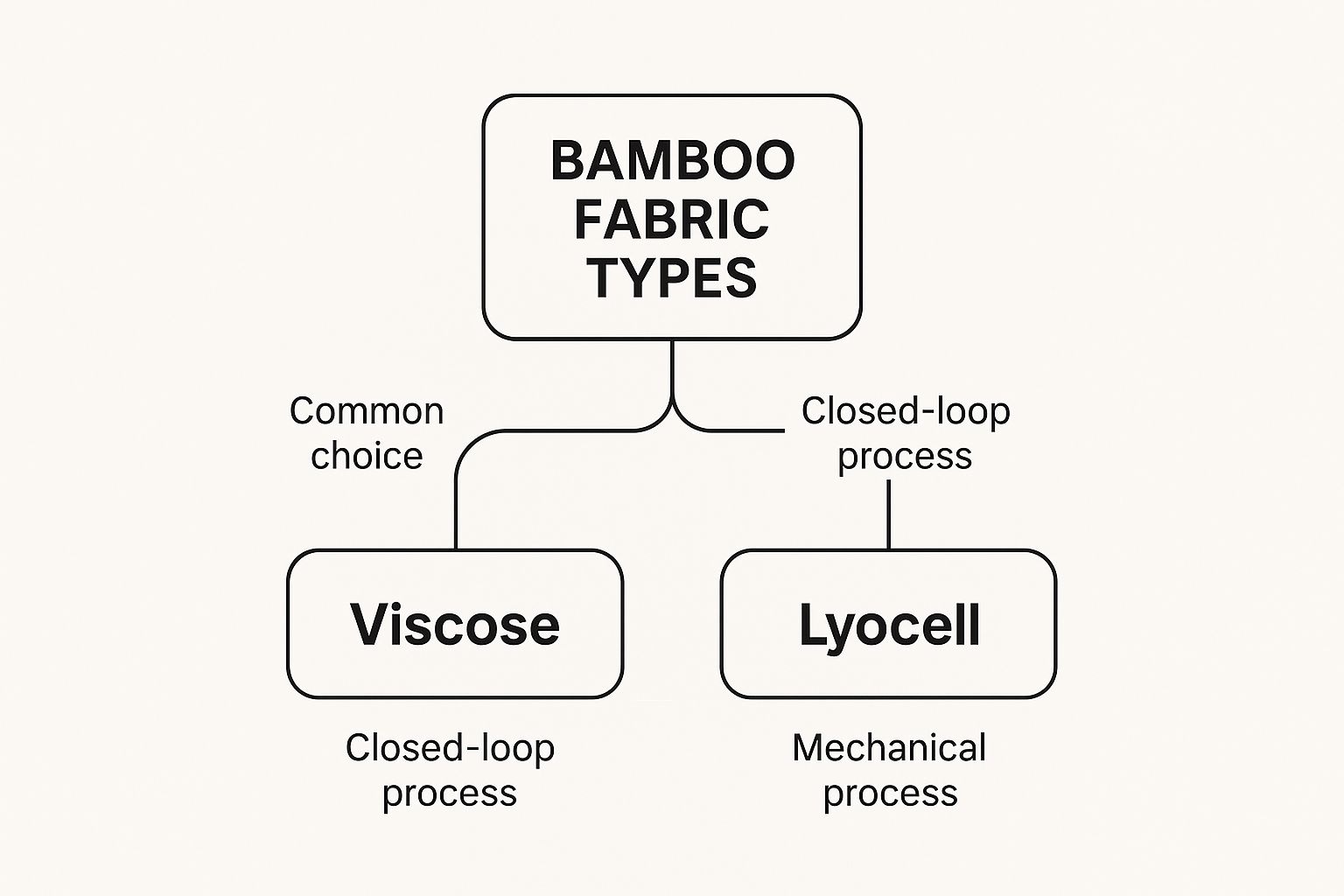
As you can see, the real distinction is in the processing: is it a traditional chemical method (Viscose/Rayon), a purely mechanical one (Linen), or a modern, eco-conscious chemical system (Lyocell)? Getting your head around these methods is the key to choosing wisely.
Bamboo Viscose: The Common Choice
Bamboo viscose, which you’ll often see labelled as "bamboo rayon," is the most widespread type on the market. It’s popular for a good reason—it delivers that signature silky softness and elegant drape that bamboo sheets are famous for, often at a more accessible price.
The process involves dissolving bamboo pulp in a chemical solution to create a thick, honey-like liquid (that's where the name "viscose" comes from). This mixture is then pushed through a spinneret to form fine threads, which are woven into fabric. While it’s an effective method, it can be chemically intensive unless it’s done in a modern, closed-loop facility that manages its waste responsibly.
Bamboo Lyocell: The Eco-Innovator
Bamboo Lyocell is a huge leap forward in sustainable textile production. It also uses a solvent to dissolve the bamboo pulp, but the system is far smarter and much kinder to the planet.
Picture a completely self-contained cycle. Lyocell is made using a closed-loop process, where over 99% of the non-toxic solvent and water are captured, cleaned up, and used over and over again. This massively cuts down on waste and prevents chemical runoff, making it a much greener choice. The fabric itself is incredibly smooth, strong, and highly breathable—often seen as the premium option.
For the environmentally conscious Kiwi, Bamboo Lyocell is usually the top pick. Its closed-loop manufacturing system offers that sought-after luxury feel without the environmental compromise.
This advanced process is why Lyocell sheets can cost a bit more. You aren't just paying for superior quality; you're investing in a cleaner, more responsible technology.
Bamboo Linen: The Rustic Original
The third type, bamboo linen, is the most natural of the lot. It’s made in a purely mechanical way, just like traditional linen from flax. The woody parts of the bamboo plant are crushed, and natural enzymes help break them down so the fibres can be combed out and spun into yarn.
This chemical-free process is fantastic from an environmental perspective. However, the fabric it creates is totally different from its silky cousins. Bamboo linen has a more textured, crisp feel that gets beautifully soft with every wash, just like classic linen bedding. It’s not as common in the New Zealand market, but it’s perfect for anyone who prioritises natural processing above a silky-smooth finish.
A Quick Comparison of Bamboo Fabric Types
To help you see the differences at a glance, this table breaks down the key features of each bamboo fabric you'll find in New Zealand.
| Fabric Type | Production Method | Feel and Texture | Environmental Impact | Typical Price |
|---|---|---|---|---|
| Bamboo Viscose | Chemical (Rayon Process) | Very soft, silky, and drapey | Can be high unless chemicals are managed responsibly | $$ |
| Bamboo Lyocell | Chemical (Closed-Loop) | Exceptionally smooth, soft, and strong | Low, due to recycled solvents and water | $$$ |
| Bamboo Linen | Mechanical | Textured, breathable, and softens over time | Very low, as it's a chemical-free process | $$$$ |
Ultimately, choosing the right bamboo sheets in New Zealand is all about what matters most to you. Are you looking for classic softness on a budget, state-of-the-art sustainability, or an all-natural, rustic texture? Once you can decode the label, you can find the perfect set that aligns with both your comfort and your values.
The Real Benefits of Sleeping on Bamboo
Forget the marketing hype for a moment. The real magic of bamboo sheets isn't just in the slick photos—it's in how they feel, night after night. These aren't just small improvements to your bedding; they're genuine solutions to common sleep issues, making them a perfect match for New Zealand's famously changeable climate. From a sticky summer night in the Bay of Plenty to a frosty South Island morning, bamboo works with you, not against you.
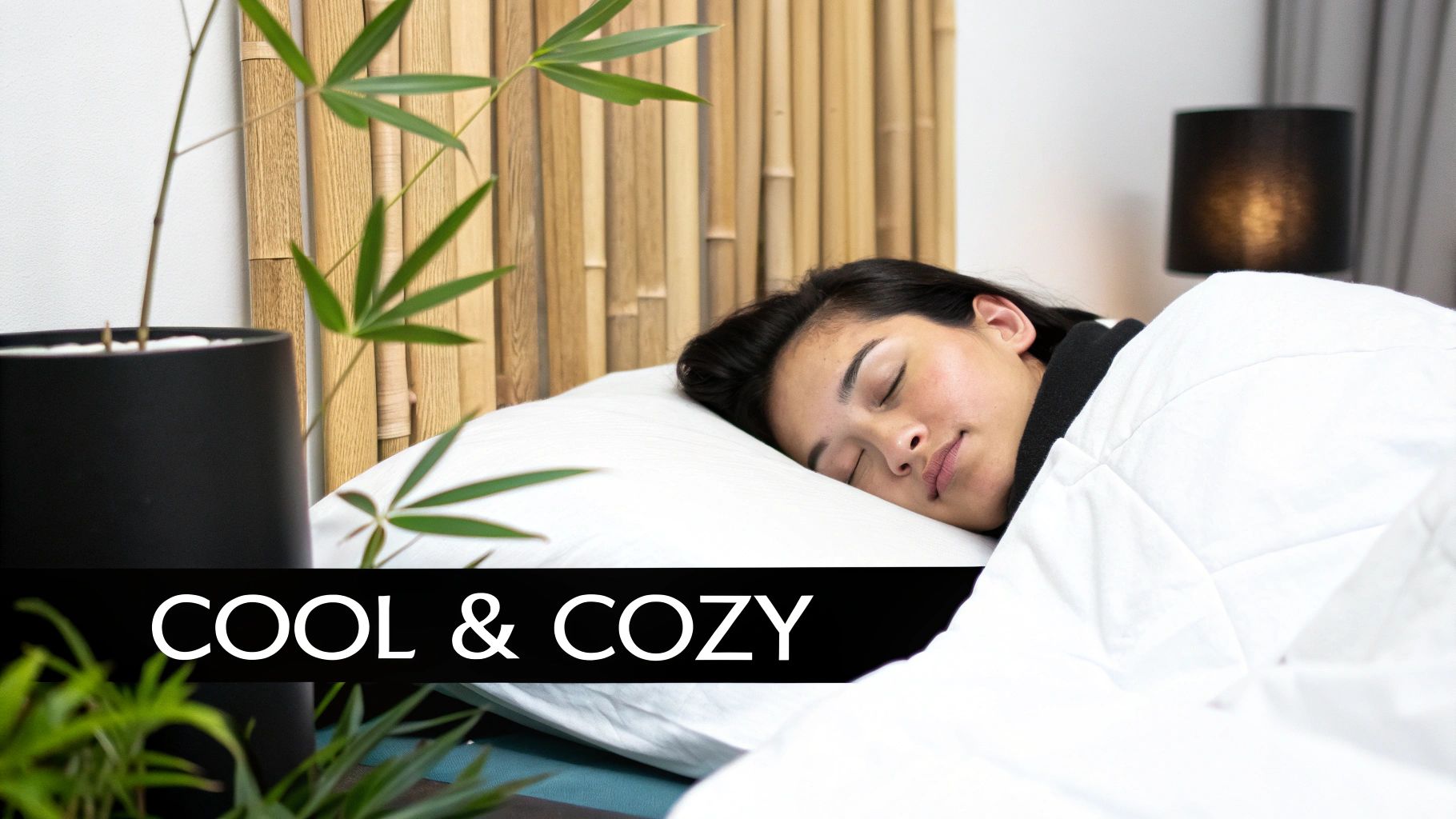
So, let's get into the practical advantages that have made bamboo sheets in New Zealand such a sought-after staple.
Your Personal Climate Control
One of the standout features of bamboo fabric is its brilliant temperature regulation. It’s not just a buzzword. The very structure of bamboo viscose and lyocell fibres is full of tiny micro-gaps, creating a uniquely breathable material that adapts to you and your room.
Think of it as a smart thermostat for your bed. When you're warm, those little gaps let heat escape, so you don't get that stuffy, trapped feeling you get with polyester. On a humid Auckland night, that breathability is a lifesaver. But when a Canterbury frost hits, those same fibres create a light, insulating layer that keeps you cosy without making you overheat. It’s this smart, responsive quality that helps you maintain a comfortable sleeping temperature right through the year.
Exceptional Moisture Wicking for Dry Nights
If you're a hot sleeper who often wakes up feeling clammy, this is where bamboo really shines. The fabric is incredibly effective at wicking moisture away from your skin.
Instead of just absorbing sweat like cotton does, bamboo pulls it away from your body and disperses it across the sheet's surface so it can evaporate quickly. This is a huge upgrade from traditional cotton, which can get damp and heavy. By keeping you drier, bamboo helps you achieve a much deeper, more restorative sleep.
A Sanctuary for Sensitive Skin
The feel of bamboo is often compared to silk or cashmere, and it’s an accurate comparison. The fibres are naturally round and smooth, completely free of the microscopic sharp spurs you might find in wool or even some lower-grade cottons.
What does this mean for you? It means far less friction against your skin. For anyone dealing with sensitivities, eczema, or allergies, this is a massive relief. The fabric simply glides over your body instead of rubbing, which helps prevent irritation and flare-ups.
Bamboo’s naturally hypoallergenic properties also help create a healthier sleep space. The fabric is resistant to dust mites and other common allergens, making it a clean and calming sanctuary for anyone with allergies or asthma.
This gentle touch makes bamboo sheets an ideal choice for a pure, non-irritating place to rest. Of course, great sheets are just one part of the equation. If you're looking to improve your wind-down routine, you can explore proven sleep stories for adults for more ways to drift off peacefully.
Lasting Softness and Durability
While they feel incredibly delicate, high-quality bamboo sheets are surprisingly tough. The long, silky fibres are far less likely to break, fray, or pill compared to the shorter fibres found in many cotton weaves.
With the right care, your sheets will keep that luxurious, brand-new feel for years to come. This blend of strength and softness makes investing in bamboo sheets New Zealand a truly practical decision for anyone serious about long-term comfort and better sleep.
Are Bamboo Sheets Really Eco-Friendly? Let's Take a Closer Look
In New Zealand, we take our "clean, green" reputation seriously, so when a product is labelled "eco-friendly," it's only right to ask a few questions. Bamboo sheets are often marketed as a sustainable choice, but the story isn't quite as simple as a fast-growing plant.
This isn't about dismissing bamboo's green credentials outright. It’s about giving you the full picture so you can make a choice you feel genuinely good about. To do that, we need to separate the plant from the production line.
The Good News: The Bamboo Plant Itself
Let’s start with the raw material, because as a plant, bamboo is a bit of a sustainability champion. It's easy to see why it gets so much praise.
- Grows Like a Weed: Seriously, some bamboo species can shoot up nearly a metre in a single day. It’s one of the fastest-growing plants on the planet, meaning it’s a rapidly renewable resource.
- Needs Very Little Fuss: Bamboo sips water compared to thirsty crops like cotton, and it generally thrives without the need for chemical pesticides or fertilisers. That’s a massive win for the environment.
- Good for the Ground: Its complex root system is brilliant for preventing soil erosion. Plus, since it's technically a grass, it regrows from its own roots after being harvested, so there's no need for constant replanting.
So, when it comes to farming, bamboo is undeniably a low-impact and sustainable choice. But the journey from the field to your bed is where things get a bit more complicated.
The Reality of Manufacturing
Turning a tough, woody stalk into a silky-soft sheet is a pretty intensive process. As we’ve talked about, most bamboo fabric is either viscose or lyocell, and both rely on chemicals to break down the plant fibres.
The traditional viscose process, in particular, can be a real problem. It often involves harsh chemicals like carbon disulphide. If these aren't managed in a modern, closed-loop system, they can pose risks to factory workers and the local environment. This is the crucial detail that separates a truly "green" product from clever marketing.
This is a big deal in the global bed linen industry, which is tipped to reach US$55.9 billion by 2032, with a lot of that growth coming from plant-based fabrics. Here in NZ, our environmental values mean we’re naturally drawn to bamboo, but it's important to know that not all production methods are created equal.
How to Be Sure: The Power of Certifications
So, how do you sort the good from the questionable? The answer is to look for independent certifications. These labels are your best tool for cutting through the marketing fluff and verifying a brand's promises.
Think of a certification as an independent referee. It steps in to confirm that a product meets specific, measurable standards for both environmental and human safety.
When you're shopping for bamboo sheets in New Zealand, keep an eye out for these two key certifications:
- OEKO-TEX® STANDARD 100: This is one of the world's most trusted labels for textiles tested for harmful substances. When sheets carry this certification, it means every single part of them—the fabric, the thread, even the buttons—has been tested and cleared of a long list of nasty chemicals. It’s your best guarantee for a healthy home. For a deeper dive, check out our guide on what OEKO-TEX® certified really means.
- Forest Stewardship Council (FSC): This one is all about the source. The FSC logo confirms that the bamboo was harvested from a responsibly managed forest. It’s an assurance that the process protects biodiversity, respects the rights of local workers and communities, and keeps the forest ecosystem healthy.
Finding these labels on a product means you're buying more than just comfort. It means you're supporting a brand that has invested in doing things the right way, with a genuine commitment to you and the planet.
How to Choose the Best Bamboo Sheets in NZ
So, you're ready to make the switch to bamboo sheets? Great decision. But with all the options out there, it’s easy to get bogged down in technical details and marketing jargon. Let’s cut through the noise. This guide will give you a simple, practical framework for finding the perfect bamboo sheets in New Zealand, ensuring you invest in a set that truly lives up to the promise of incredible comfort.
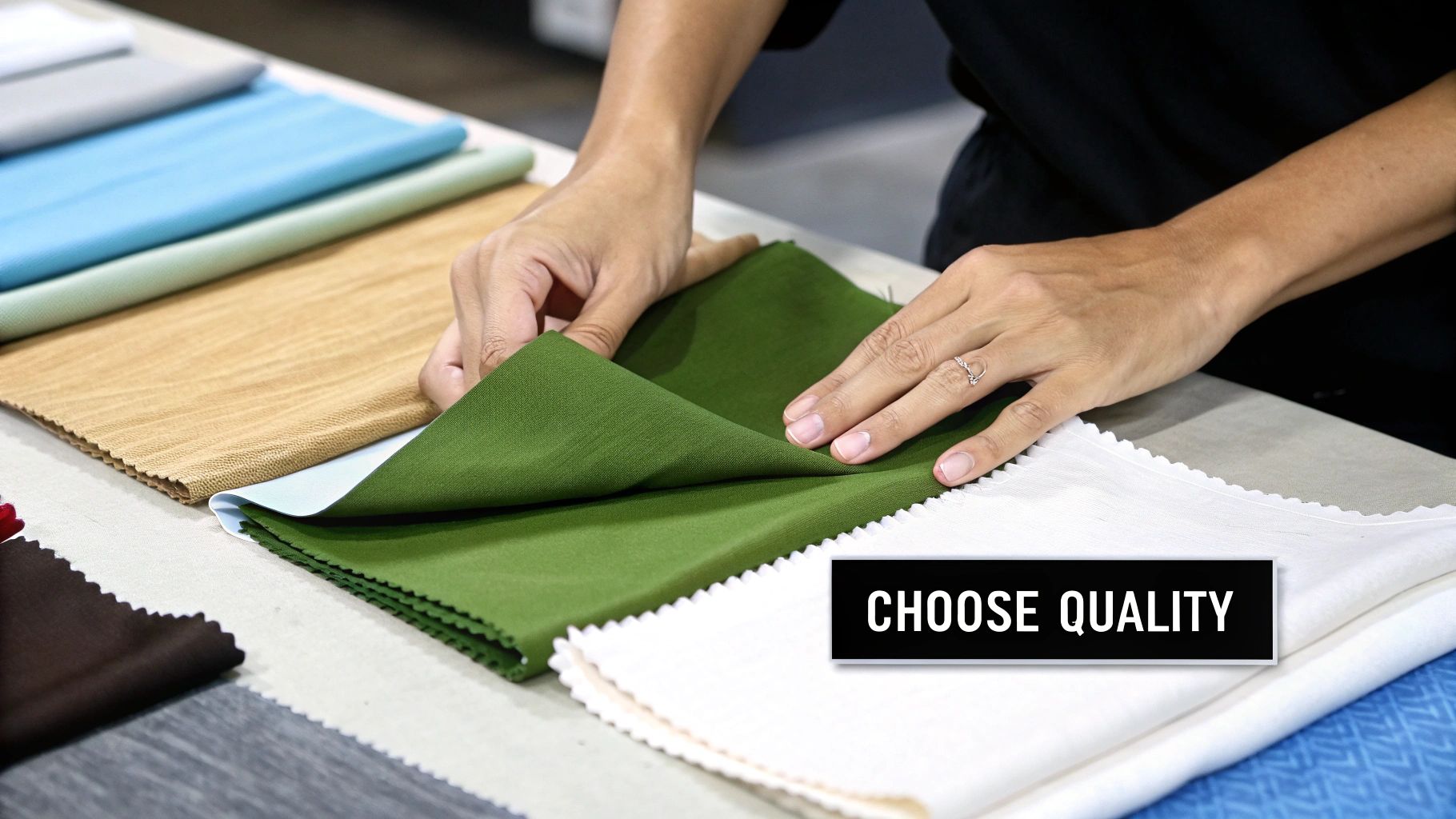
Look Beyond the Thread Count
First things first, let's bust a common myth: a higher thread count does not automatically mean better sheets. While that’s a decent rule of thumb for cotton, it’s a different story with bamboo.
Bamboo fibres are naturally long and silky, which means they can create an exceptionally soft fabric without being woven tightly together. In fact, a bamboo sheet set with a thread count between 250 and 500 is often the sweet spot. Go much higher, and you risk sacrificing breathability—one of bamboo’s best qualities.
Instead of getting hung up on thread count, your focus should be on the weave. The weave is what truly shapes the feel and finish of the fabric, playing a far bigger role in your comfort than just a number.
Sateen vs Twill Weave: What’s the Difference?
When you’re looking at bamboo sheets, you'll mainly come across two different weaves. Each offers a completely distinct experience.
- Sateen Weave: This is the go-to for that signature silky, luxurious feel. The weaving pattern (one-yarn-under, three-or-four-yarns-over) puts more threads on the surface, creating a lustrous sheen and a beautiful drape that feels incredible against the skin. If you want to replicate that five-star hotel bed feeling, sateen is your best bet.
- Twill Weave: You'll recognise this diagonal pattern from your favourite pair of jeans, but in bamboo, it's infinitely softer and finer. Twill creates a fabric that’s a little thicker and cosier than sateen, with less shine. It's incredibly durable and less prone to wrinkling, making it a fantastic, low-maintenance option for everyday luxury.
Spotting True Quality in the Details
The small things often make the biggest difference. The gap between a good set of bamboo sheets and a great one is all in the craftsmanship. Whether you're shopping online or in a store, keep an eye out for these markers of quality:
- Stitching and Seams: Take a close look at the hems. Are the stitches tight and even? Are there any loose threads? Double-stitched seams are a clear indicator of a well-made product built to last.
- Fabric Consistency: The colour and texture should be uniform across the entire sheet. Any patchiness or unevenness can be a red flag for lower-quality manufacturing.
- Brand Reputation: Look for brands that are open about where and how their products are made. Certifications like OEKO-TEX® are a huge plus, as they guarantee the fabric is free from harmful chemicals.
For instance, a premium offering like this luxury bamboo sheet set will usually tick all these boxes, giving you confidence that you're buying a top-tier product.
Navigating the Online Marketplace
More and more Kiwis are buying their bedding online. Projections show that the number of online bedding shoppers in New Zealand is set to reach 190,200 by 2030. This boom gives you a massive amount of choice, but it also means you need to be a savvy shopper.
To make sure you’re getting what you pay for, here’s what to look for:
- Read Kiwi Reviews: Don't just skim the star ratings. Read detailed reviews from fellow New Zealanders to get a real sense of how the sheets feel, how they wash, and what the company's customer service is actually like.
- Understand the Return Policy: A confident brand will stand behind its product. Look for a clear and fair return policy—a 30-day trial period is a fantastic sign that the company believes in its quality.
- Check for Fabric Samples: Some of the best online retailers offer fabric swatches. This is a brilliant way to feel the texture and see the true colour in your own home before you commit.
Armed with this checklist, you can confidently navigate the options and find a set of bamboo sheets that will deliver years of restful, luxurious sleep.
Caring for Your Bamboo Bedding
https://www.youtube.com/embed/SdGyQo3m64s
So, you've invested in that cloud-like comfort of bamboo sheets. Good on you! With just a bit of TLC, you can keep that silky, soft feel going for years. While bamboo is a surprisingly hardy fabric, its long, smooth fibres need a gentler touch than your old-school cotton or poly-blends.
Think of it like washing a favourite merino wool top – you wouldn't just chuck it in a hot wash with your jeans and towels. The same idea applies here. High heat and harsh chemicals are the enemies of bamboo’s signature softness, as they can damage the very fibres that make the fabric so special. A little care goes a long way.
Your Ideal Washing Routine
For the best results, give your bamboo sheets a wash all on their own. This simple step stops them from getting snagged on zips, buttons, or rougher fabrics.
- Keep it Cool: Always opt for a cold or cool wash, making sure the temperature stays below 30°C. Hot water is a real no-go, as it can cause the fibres to shrink and lose that beautiful sheen.
- Go Gentle: Select the gentle or delicates cycle on your machine. This miminises the mechanical stress on the fabric, preventing pilling and unnecessary wear.
- Mild Detergent is a Must: A mild, liquid detergent is your best friend here. Powdered detergents can sometimes leave a residue, and harsh chemicals will only weaken the fibres over time.
Here's the most important rule of thumb: never use fabric softeners or bleach. Fabric softeners actually coat the bamboo fibres, which clogs them up and reduces their amazing natural breathability and moisture-wicking abilities. Bleach is simply too aggressive and will cause irreversible damage.
Drying for Lasting Softness
How you dry your sheets is every bit as important as how you wash them. To get that incredible fresh-air softness, you just can't beat line drying.
Hanging your sheets out in the New Zealand breeze is the ideal way to go. The sun is a natural sanitiser, and the gentle air movement helps prevent deep-set wrinkles. If you need to use a tumble dryer, always choose the lowest heat setting or a 'cool air' cycle. Make sure to pull them out as soon as they're done to stop wrinkles from forming. Remember, high heat is the number one enemy of bamboo fabric; it makes the fibres brittle and shortens the life of your sheets.
Following this simple routine will ensure your bed remains a soft, healthy, and inviting sanctuary night after night. While these tips are specific to bamboo, you can also learn more about making cotton sheets last in our other guides.
Common Questions About Bamboo Sheets
It's completely normal to have a few questions when you're looking into something new like bamboo bedding. To help you out, we've gathered the most common queries we get from Kiwis curious about bamboo sheets in New Zealand and answered them straight up.
Are Bamboo Sheets Better Than Egyptian Cotton?
This is a classic question, and the honest answer is: they’re just different. One isn't inherently "better" than the other; it all comes down to the kind of sleep experience you're after.
Bamboo is all about that silky, buttery softness. It’s incredibly breathable and brilliant at wicking away moisture, which is why hot sleepers and people with sensitive skin absolutely rave about it.
Egyptian cotton, on the other hand, delivers that crisp, cool, five-star hotel feeling. It's famous for its durability and classic texture. So, the real question is for you: do you prefer a soft, drapey fabric that cocoons you (bamboo), or a crisp, cool sheet that feels fresh and structured (cotton)?
Think of it like this: bamboo is a gentle, adaptive hug, while Egyptian cotton is a cool, refreshing retreat.
Do Bamboo Sheets Wrinkle or Pill?
Bamboo fabric does have a natural tendency to wrinkle a bit, but it's nothing to worry about. The easiest fix is to pull your sheets from the dryer the moment they're done, or even better, let them line dry in the fresh air.
As for pilling (those annoying little fluff balls), it’s extremely rare with high-quality bamboo. Good craftsmanship makes all the difference.
The secret to keeping them smooth and pill-free is simply good care. Wash them on a cold, gentle cycle, steer clear of harsh detergents, and never, ever wash them with rough items like towels or jeans.
How Much Should I Expect to Pay in New Zealand?
For a good quality queen-sized set of bamboo sheets in New Zealand, you should budget anywhere from $150 to over $300 NZD.
What causes that price difference? It usually comes down to the type of fabric (eco-friendly Lyocell costs more to produce than viscose), the specific weave, and the overall quality of the brand. While they might seem like a bit of an investment upfront compared to standard cotton, their incredible softness and how well they last make them a worthwhile luxury for any bedroom.
Ready to feel the difference for yourself? Experience the perfect blend of comfort and conscious living. Discover the beautiful range of luxury bedding at The Foxes Den and find your perfect set today. Visit us at https://www.thefoxesden.co.nz.
